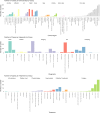Survival time and prognostic factors in dogs clinically diagnosed with haemangiosarcoma in UK first opinion practice
- PMID: 40478827
- PMCID: PMC12143555
- DOI: 10.1371/journal.pone.0316066
Survival time and prognostic factors in dogs clinically diagnosed with haemangiosarcoma in UK first opinion practice
Abstract
Visceral haemangiosarcoma is considered clinically aggressive in dogs, with perceived poor prognosis often leading to euthanasia at presentation. This study aimed to determine survival times and prognostic factors in dogs with haemangiosarcoma under first-opinion care. Dogs clinically diagnosed with haemangiosarcoma in first-opinion practice in 2019 were identified in VetCompass electronic health records and examined to capture variables potentially associated with survival. Median survival time (MST) from diagnosis was calculated for the whole population, those histopathologically confirmed and based on primary tumour location. Binary logistic regression was used to explore differences between dogs that died on the day of diagnosis and those that survived ≥1 day. Cox proportional hazards modelling explored factors associated with time to death in dogs surviving ≥1 day. Across all cases (n = 788), overall MST was 9.0 days (95%CI:5.0-15.0, range: 0-1789) and proportional 1-year survival was 12.0% (95%CI:9.7-15.0%). Dogs with splenic (MST = 4.0 days, 95%CI 0.0-9.0) and cutaneous haemangiosarcoma (MST = 119.0 days,95%CI:85.0-248.0) had MST greater than 0 days. Of dogs with a histopathological diagnosis of haemangiosarcoma, overall MST was longer at 105 days (95% CI 84-133 days) and additionally, location-specific MST were longer. For both clinically diagnosed cases and histopathologically confirmed cases, increasing tumour size was associated with increased hazard of death while cutaneous location and surgery were associated with reduced hazard of death. A very short survival time was identified for haemangiosarcoma under first-opinion care. Although survival time was longest for cutaneous cases, the actualised prognosis was poor overall for haemangiosarcoma. However, a common prevailing view of extremely poor prognosis for haemangiosarcoma could be promoting frequent euthanasia at presentation and therefore leading to a self-fulfilling prophecy and low survival times. Further exploration of the potential effect of perceived prognosis is warranted. This study provides valuable information for contextualised care and dialogues with clients in first-opinion practice.
Copyright: © 2025 Taylor et al. This is an open access article distributed under the terms of the Creative Commons Attribution License, which permits unrestricted use, distribution, and reproduction in any medium, provided the original author and source are credited.
Conflict of interest statement
Julia Labadie is an employee of the Morris Animal Foundation and authors Collette Taylor and Georgina Barry’s work is funded by a grant from the Morris Animal Foundation. This does not alter our adherence to PLOS ONE policies on sharing data and materials.
Figures





Similar articles
-
Canine Cutaneous Haemangiosarcoma: Biomarkers and Survival.J Comp Pathol. 2019 Jan;166:87-96. doi: 10.1016/j.jcpa.2018.10.181. Epub 2018 Dec 18. J Comp Pathol. 2019. PMID: 30691610
-
Does thalidomide prolong survival in dogs with splenic haemangiosarcoma?J Small Anim Pract. 2018 Feb;59(2):85-91. doi: 10.1111/jsap.12796. Epub 2017 Dec 6. J Small Anim Pract. 2018. PMID: 29210452
-
Descriptive analysis of haemangiosarcoma occurrence in dogs enrolled in the Golden Retriever lifetime study.Vet Comp Oncol. 2023 Dec;21(4):700-708. doi: 10.1111/vco.12933. Epub 2023 Aug 27. Vet Comp Oncol. 2023. PMID: 37635246
-
Prognostic value of tumour-related factors associated with canine retroperitoneal hemangiosarcoma in comparison with other anatomic presentations: A retrospective observational study.Vet Med Sci. 2024 Jul;10(4):e1495. doi: 10.1002/vms3.1495. Vet Med Sci. 2024. PMID: 38889089 Free PMC article.
-
Clinical outcome and prognosis of dogs with histopathological features consistent with epitheliotropic lymphoma: a retrospective study of 148 cases (2003-2015).Vet Dermatol. 2018 Apr;29(2):154-e59. doi: 10.1111/vde.12504. Epub 2017 Oct 6. Vet Dermatol. 2018. PMID: 28983988 Review.
References
-
- De Nardi AB, de Oliveira Massoco Salles Gomes C, Fonseca-Alves CE, de Paiva FN, Linhares LCM, Carra GJU, et al.. Diagnosis, prognosis, and treatment of canine hemangiosarcoma: A review based on a consensus organized by the Brazilian Association of Veterinary Oncology, ABROVET. Cancers. 2023;15. - PMC - PubMed
-
- Barry G. The epidemiology of canine haemangiosarcoma. 2024.
-
- Withrow SJ, Vail DM, Page RL. Withrow & MacEwen’s small animal clinical oncology. 5th ed. Missouri: Elsevier Saunders; 2013.
-
- Hillers KR, Lana SE, Larue SM. Effects of palliative radiation therapy on nonsplenic hemangiosarcoma in dogs [Internet]. J Am Anim Hosp Assoc. 2007;43(4). Available from: http://meridian.allenpress.com/jaaha/article-pdf/43/4/187/1333045/043018... - PubMed
MeSH terms
LinkOut - more resources
Full Text Sources
Medical

